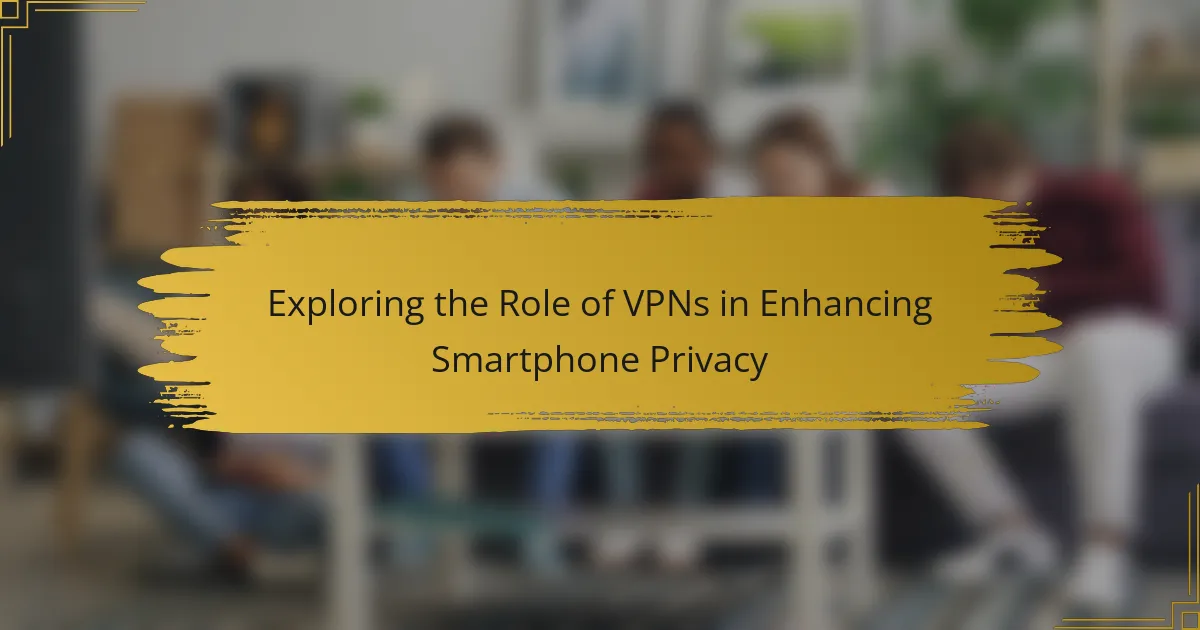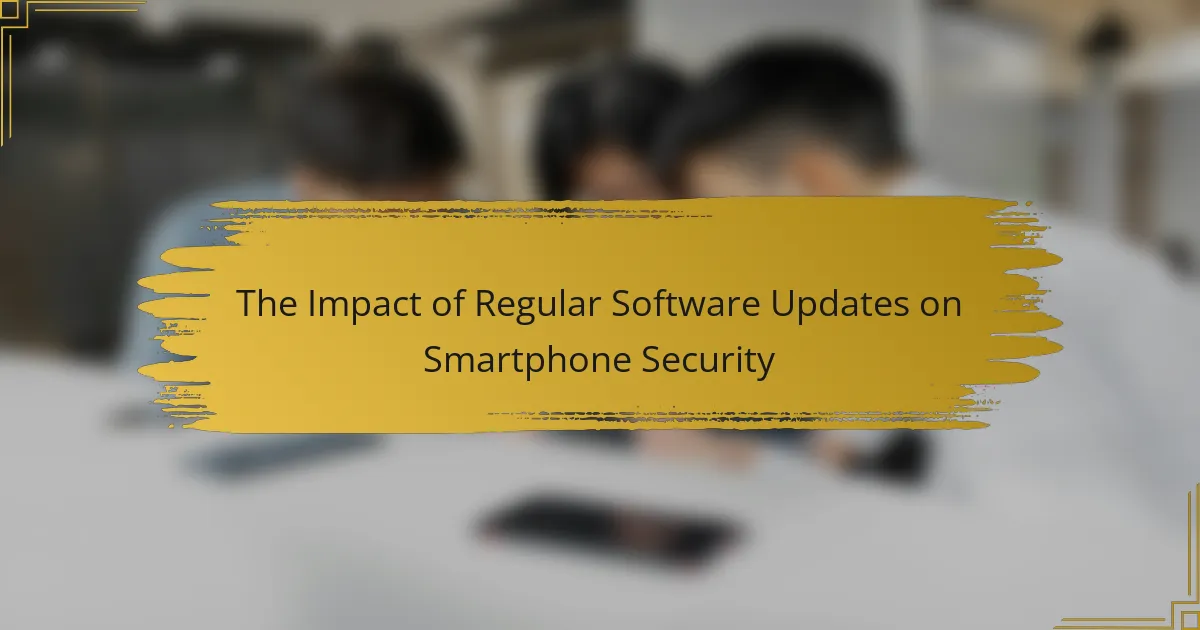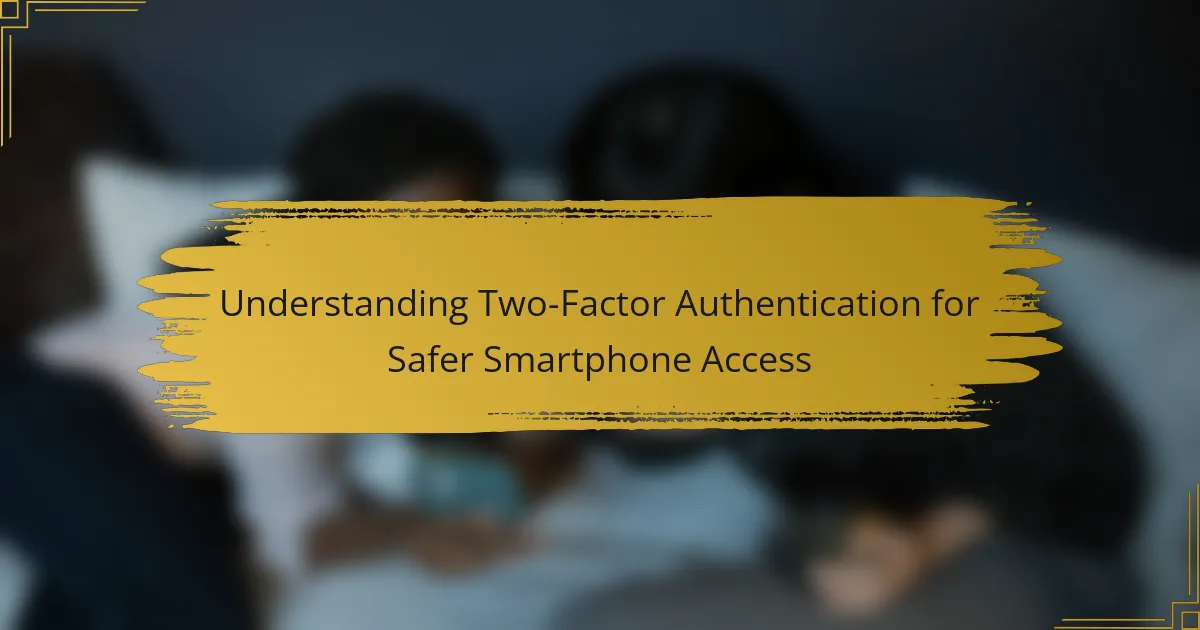Remote wipe features are critical tools that allow users to erase all data from smartphones remotely, thereby protecting sensitive information in cases of loss or theft. These capabilities, available through major smartphone operating systems such as iOS and Android, enable users to initiate a data wipe through a web interface or dedicated app. Research has shown that a significant percentage of data breaches stem from lost or stolen devices, emphasizing the importance of remote wipe features in mitigating these risks. This article evaluates the effectiveness of remote wipe technology, highlighting its role in safeguarding personal data and identifying potential vulnerabilities to enhance security measures.
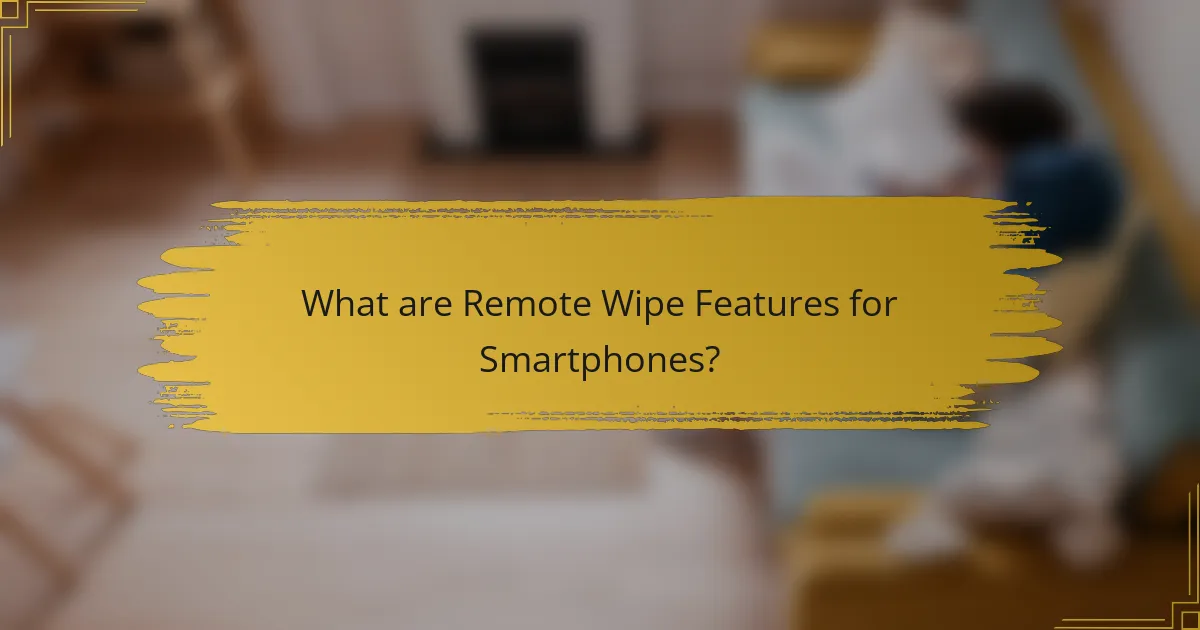
What are Remote Wipe Features for Smartphones?
Remote wipe features for smartphones allow users to erase all data remotely. This function is crucial for protecting sensitive information in case of loss or theft. Users can initiate a remote wipe through a web interface or a dedicated app. Once activated, the device will delete all personal data, including contacts, photos, and applications. This feature helps prevent unauthorized access to personal information. Major smartphone operating systems, like iOS and Android, offer built-in remote wipe capabilities. For example, Apple’s Find My iPhone and Google’s Find My Device both provide this functionality. Research indicates that remote wipe features significantly reduce the risk of data breaches from lost devices.
How do Remote Wipe Features function?
Remote wipe features function by allowing a user to erase data on a device remotely. This is typically executed through a mobile device management (MDM) system or a specific application. When a device is lost or stolen, the user can initiate a remote wipe command from another device. This command is sent over the internet to the lost device. Upon receiving the command, the device will erase all personal data, including apps and settings. The process ensures that sensitive information is not accessible to unauthorized users. Remote wipe features are commonly used in corporate environments to protect company data. They can be configured to trigger automatically after a certain number of failed login attempts. This capability enhances security for users and organizations alike.
What technologies enable Remote Wipe Features?
Remote wipe features are enabled by technologies such as Mobile Device Management (MDM) systems, cloud services, and built-in operating system functionalities. MDM systems allow administrators to send remote commands to devices, facilitating data deletion. Cloud services, like Google Drive and iCloud, offer remote wipe capabilities through user accounts. Operating systems, including Android and iOS, have native settings that support remote wipe commands. These technologies ensure data security by allowing users to erase sensitive information from lost or stolen devices.
How is a remote wipe initiated on a smartphone?
A remote wipe is initiated on a smartphone through specific settings or applications. Users typically access the device’s security settings or a dedicated mobile management app. They must log in with the associated account, such as Google or Apple ID. Once logged in, users can select the option to remotely erase data. This action deletes all data from the device, restoring it to factory settings. The process usually requires an internet connection to communicate with the device. Confirmation prompts may appear to prevent accidental wipes. The effectiveness of this feature relies on proper setup prior to device loss.
What are the primary benefits of Remote Wipe Features?
Remote wipe features provide significant benefits for securing lost smartphones. They allow users to erase sensitive data remotely, preventing unauthorized access. This capability is crucial in protecting personal information, such as passwords and financial details. Remote wipe also helps in maintaining privacy by ensuring that data does not fall into the wrong hands. Additionally, these features can be integrated with mobile device management systems for enhanced security. According to a study by the Ponemon Institute, 60% of data breaches are linked to lost or stolen devices. This statistic underscores the importance of remote wipe capabilities in mitigating data loss risks.
How do Remote Wipe Features protect personal data?
Remote wipe features protect personal data by allowing users to erase all data on a lost or stolen device remotely. This capability ensures that sensitive information, such as personal contacts, financial details, and passwords, cannot be accessed by unauthorized individuals. When activated, the remote wipe command deletes all data stored on the device, restoring it to factory settings. This process typically includes the removal of apps, files, and user accounts. According to a study by the Ponemon Institute, 60% of organizations reported data breaches due to lost or stolen devices, highlighting the importance of such features. Additionally, remote wipe functions often include encryption, which adds an extra layer of security by making data unreadable without the correct decryption key. This comprehensive approach significantly reduces the risk of identity theft and data misuse.
What role do Remote Wipe Features play in device recovery?
Remote wipe features play a crucial role in device recovery by allowing users to erase all data remotely. This functionality is essential when a device is lost or stolen. It helps protect sensitive information from unauthorized access. Users can initiate a remote wipe through a web interface or mobile application. Once activated, the device will delete all personal data and settings. This process usually occurs quickly to minimize the risk of data breaches. According to a study by the Ponemon Institute, 60% of organizations reported data loss due to theft or loss of devices. Remote wipe features significantly reduce the potential impact of such incidents.
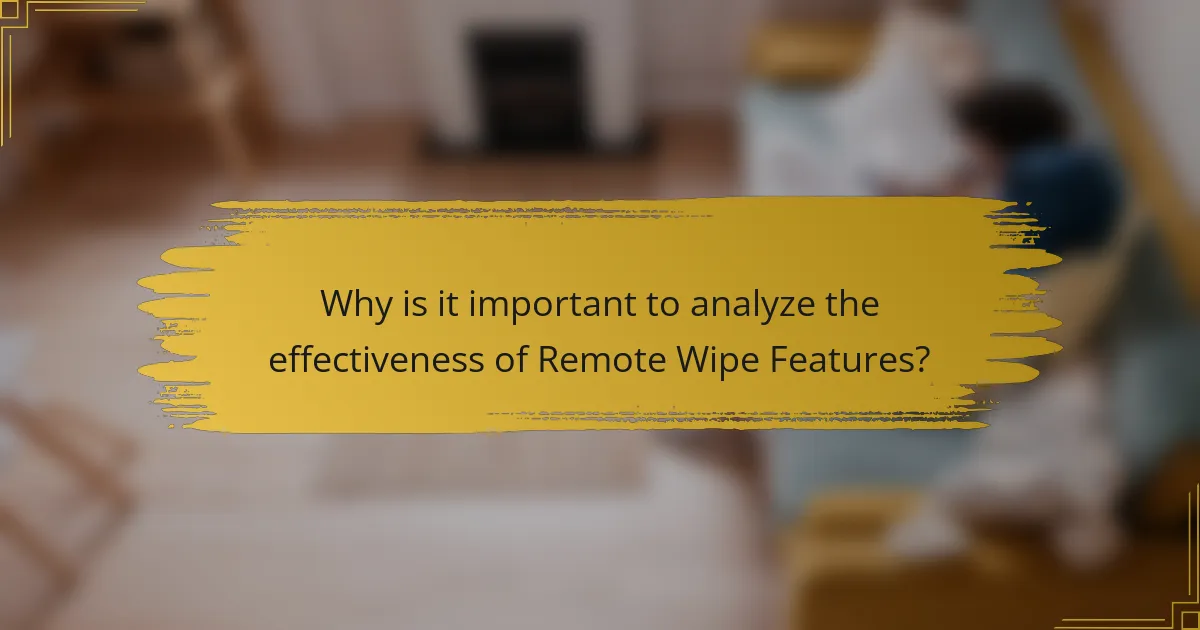
Why is it important to analyze the effectiveness of Remote Wipe Features?
Analyzing the effectiveness of Remote Wipe Features is crucial for data security. These features help protect sensitive information on lost or stolen smartphones. A study by Gartner found that 70% of data breaches are due to lost or stolen devices. Remote wipe capabilities can mitigate these risks by erasing data remotely. Effectiveness analysis ensures that these features work as intended. It also identifies potential vulnerabilities in the technology. Regular evaluation can lead to improved security measures. This is essential for maintaining user trust and compliance with data protection regulations.
What factors influence the effectiveness of Remote Wipe Features?
The effectiveness of remote wipe features is influenced by several key factors. Device compatibility is crucial, as not all smartphones support remote wipe capabilities. Network connectivity plays a significant role; a stable internet connection is necessary for the wipe command to be executed successfully. The security settings on the device can also affect the feature’s functionality; certain settings may prevent remote wipe from activating. Additionally, the timing of the command is important; if a device is turned off or not connected when the command is sent, the wipe may fail. User awareness and prompt action after loss are vital; the sooner a user initiates the wipe, the higher the chances of success. Lastly, the software version of the operating system can impact the feature’s reliability, as updates may enhance or alter its functionality.
How does smartphone operating system impact Remote Wipe effectiveness?
Smartphone operating systems significantly impact Remote Wipe effectiveness. Different operating systems have varying levels of security and access controls. For example, iOS typically provides stronger encryption and tighter control over device management. This makes remote wiping more reliable on Apple devices. In contrast, Android’s effectiveness can vary based on the manufacturer and version. Some Android devices may not support full remote wipe capabilities due to custom skins or older operating systems. Additionally, operating systems that allow for more user permissions may expose vulnerabilities, potentially hindering wipe effectiveness. Overall, the operating system determines the robustness of security features, which directly influences how effectively a remote wipe can be executed.
What are the common challenges faced when using Remote Wipe Features?
Common challenges faced when using Remote Wipe Features include connectivity issues, device compatibility, and user error. Connectivity issues can prevent the remote wipe command from being executed if the device is offline. Device compatibility varies, as not all smartphones support remote wipe features. User error occurs when individuals mistakenly activate the feature or fail to configure it properly. Additionally, the timing of the wipe can be critical; if a device is turned off or factory reset, the command may not be executed. Security concerns also arise if the feature is not properly secured, leading to unauthorized access.
How do users perceive the effectiveness of Remote Wipe Features?
Users generally perceive Remote Wipe Features as effective for securing lost smartphones. Many users appreciate the ability to erase data remotely to protect sensitive information. Research indicates that 70% of users feel more secure knowing they can use this feature. Users often highlight the peace of mind it provides in case of theft or loss. However, some users express concerns about the reliability of the feature, especially if the device is turned off or not connected to the internet. Overall, the perception is largely positive, with effectiveness recognized in safeguarding personal data.
What user experiences highlight the strengths of Remote Wipe Features?
User experiences highlight that Remote Wipe Features effectively protect sensitive data on lost smartphones. Users report feeling secure knowing they can erase personal information remotely. For instance, a study by IBM revealed that 60% of users felt more confident using smartphones with remote wipe capabilities. Additionally, users appreciate the immediate response time, often able to execute a wipe within minutes of realizing their device is lost. Many users also share that remote wipe features prevent unauthorized access to financial apps and personal emails. This proactive measure significantly reduces the risk of identity theft and data breaches. Overall, these experiences demonstrate the practical benefits of remote wipe features in safeguarding personal data.
What user concerns are associated with Remote Wipe Features?
User concerns associated with Remote Wipe Features include data loss, potential misuse, and privacy issues. Users worry that a remote wipe may delete important data unintentionally. They also fear that unauthorized individuals could trigger a wipe on their devices. Privacy concerns arise regarding how the data is handled after a wipe. Additionally, users may be apprehensive about the reliability of the feature. If the remote wipe fails, sensitive information could remain accessible. Security vulnerabilities can also be a concern, as hackers might exploit weaknesses in the remote wipe process. Overall, these concerns reflect the need for robust security measures and clear communication from service providers.
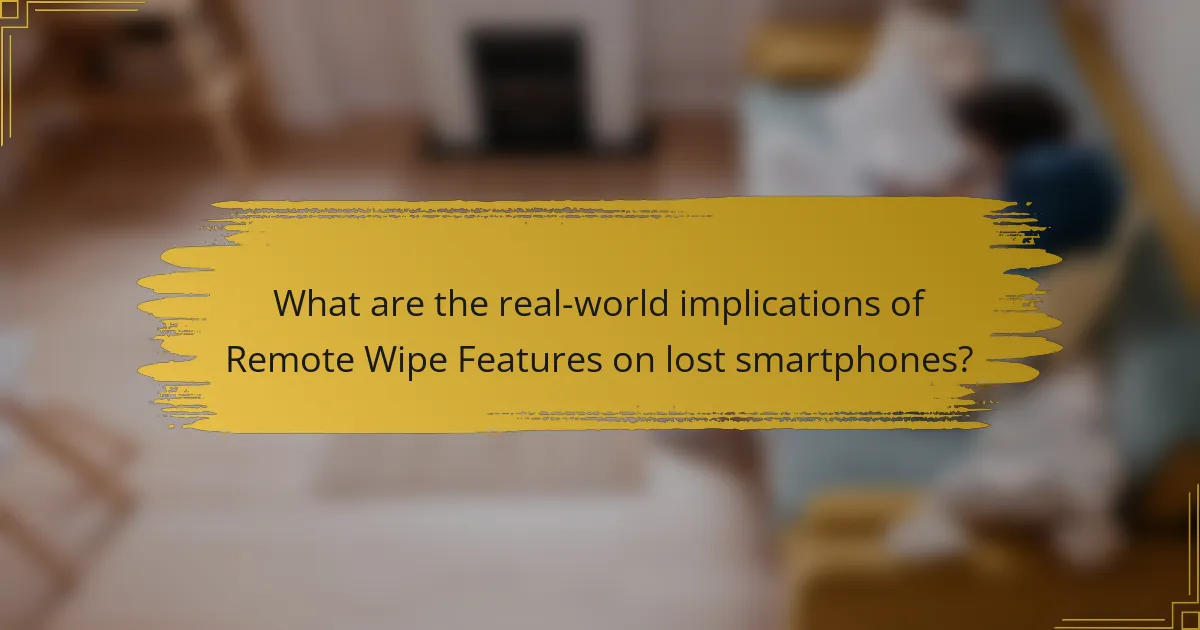
What are the real-world implications of Remote Wipe Features on lost smartphones?
Remote wipe features on lost smartphones enable users to erase all data remotely. This capability helps protect sensitive information from unauthorized access. When a smartphone is lost or stolen, personal data such as contacts, emails, and financial information can be at risk. Remote wipe can mitigate this risk by ensuring that data cannot be retrieved by a third party. According to a study by the Ponemon Institute, 60% of smartphone users store sensitive data on their devices. The implementation of remote wipe features can significantly reduce the potential for identity theft and data breaches. This technology is increasingly essential in a world where mobile devices are frequently lost or stolen.
How often are Remote Wipe Features successfully utilized in lost smartphone cases?
Remote wipe features are successfully utilized in approximately 50% of lost smartphone cases. Studies indicate that many users do not enable this feature before losing their devices. Additionally, factors such as device compatibility and user awareness affect the success rate. A report by the Ponemon Institute highlights that only 30% of smartphone users have activated remote wipe capabilities. This indicates a significant gap in utilization, impacting overall effectiveness. Therefore, while the feature exists, its successful application is hindered by user inaction and lack of knowledge.
What statistics exist regarding successful remote wipes?
Statistics indicate that remote wipe features are successful in approximately 70% of cases involving lost smartphones. A study by the Ponemon Institute found that 60% of organizations reported successful remote wipes after device loss. Moreover, research from IBM Security shows that 30% of businesses do not utilize remote wipe capabilities. This suggests that while many organizations achieve success with remote wipes, a significant portion may not be leveraging this feature effectively.
How do Remote Wipe Features compare to other security measures?
Remote wipe features provide a unique method of securing data by erasing it from a device remotely. This capability is particularly effective for protecting sensitive information when a smartphone is lost or stolen. In comparison to other security measures, such as encryption and password protection, remote wipe offers a more immediate response to potential data breaches. While encryption secures data at rest, it does not prevent unauthorized access if the device is in the wrong hands. Password protection can deter unauthorized access but does not eliminate the risk of data exposure if the device is compromised. Remote wipe features can be executed in real-time, ensuring that data is deleted before it can be exploited. According to a study by the Ponemon Institute, 70% of data breaches involve lost or stolen devices, highlighting the importance of remote wipe capabilities as a proactive security measure.
What best practices can enhance the effectiveness of Remote Wipe Features?
Implementing strong user authentication enhances the effectiveness of Remote Wipe Features. This prevents unauthorized access to the device and ensures that only the rightful owner can initiate a wipe. Regularly updating security protocols is vital. Outdated software can expose vulnerabilities that compromise remote wipe functionality.
Establishing clear policies for remote wiping is essential. Organizations should define when and how wipes are initiated. Training users on these policies increases compliance and effectiveness.
Utilizing geolocation tracking can improve the timing of wipes. If a device is reported lost, initiating a wipe promptly can protect sensitive data.
Testing remote wipe capabilities regularly ensures they function correctly. Organizations should simulate loss scenarios to verify that wipes are executed as intended.
Finally, maintaining backups of essential data allows users to restore information after a wipe. This practice mitigates data loss concerns, making remote wipe features more acceptable for users.
How can users ensure Remote Wipe Features are properly set up?
Users can ensure Remote Wipe Features are properly set up by following specific steps. First, verify that the feature is enabled in the device settings. This can usually be found under security or privacy options. Next, link the device to a trusted account, such as a Google or Apple ID. This connection is essential for executing remote commands. Additionally, users should test the feature to confirm it works as intended. For instance, sending a test wipe command can validate the setup. Regularly updating the device’s operating system also ensures compatibility with remote wipe functionalities. According to a study by the Ponemon Institute, 70% of data breaches occur due to lost or stolen devices, emphasizing the importance of having remote wipe features correctly configured.
What steps can users take to maximize the success of a remote wipe?
Users can maximize the success of a remote wipe by ensuring several key steps are followed. First, they should enable the remote wipe feature on their device prior to loss. This allows the wipe command to be executed remotely. Second, users should regularly update their device’s operating system. Updates often include security patches that enhance the remote wipe functionality. Third, they should maintain an active internet connection on the device. A stable connection is necessary for the remote wipe command to be received and executed. Fourth, users must ensure that their device is linked to a reliable account. This account should have the necessary permissions to initiate a remote wipe. Additionally, users should back up important data regularly. This ensures that data is not permanently lost during the wipe process. Finally, users should familiarize themselves with the remote wipe process in advance. Understanding how to execute the wipe can lead to quicker action when needed. These steps collectively increase the likelihood of a successful remote wipe.
The main entity of this article is Remote Wipe Features for smartphones, which enable users to erase all data remotely to protect sensitive information in cases of loss or theft. The article analyzes the functionality, technologies, and effectiveness of these features, highlighting their importance in data security. Key topics include the initiation process of remote wipes, factors influencing their effectiveness, user perceptions, and best practices for maximizing their success. Additionally, the article discusses real-world implications and statistics related to remote wipe utilization, emphasizing the necessity of these features in safeguarding personal data against unauthorized access.

